american west
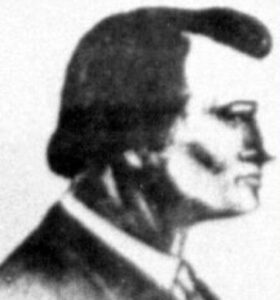 Joseph Alfred “Jack” Slade was a stagecoach and Pony Express superintendent early in his life. He was instrumental in the opening of the American West, and he was also the archetype of the Western gunslinger. Slade was born on January 22, 1831, in Carlyle, Illinois, the son of Illinois politician Charles Slade and Mary Dark (Kain) Slade. Slade’s life started out decent. He served in the US Army that occupied Santa Fe, 1847-1848, during the Mexican War. His father died in 1834, Slade’s mother married Civil War General Elias Dennis in 1838, when Slade was just seven years old.
Joseph Alfred “Jack” Slade was a stagecoach and Pony Express superintendent early in his life. He was instrumental in the opening of the American West, and he was also the archetype of the Western gunslinger. Slade was born on January 22, 1831, in Carlyle, Illinois, the son of Illinois politician Charles Slade and Mary Dark (Kain) Slade. Slade’s life started out decent. He served in the US Army that occupied Santa Fe, 1847-1848, during the Mexican War. His father died in 1834, Slade’s mother married Civil War General Elias Dennis in 1838, when Slade was just seven years old.
In about 1857, Slade married a woman named Maria Virginia. Her maiden name is unknown. In the 1850s, he was a freighting teamster and wagon master along the Overland Trail, and then became a stagecoach driver in Texas, around 1857-1858. After years on the job, Slade became a stagecoach division superintendent along the Central Overland route for Hockaday and Company from 1858–1859, and when it was purchased, he worked for its successors Jones, Russell and Company in 1859 and Central Overland, California and Pike’s Peak Express Company from 1859 to 1862. With the latter concern, he also helped launch and operate the Pony Express in 1860-61. These were critical lines of communication between the East and California. As superintendent, he enforced order and assured reliable cross-continental mail service, maintaining contact between Washington DC, and California on the eve of Civil War.
Slade was know as a strict, and even ferocious boss. While division superintendent, he shot and killed Andrew Ferrin, one of his subordinates, who was hindering the progress of a freight train, in May 1859. This type of situation was rare for the time, but it served to build his reputation as a gunslinger. In March 1860, Slade was ambushed and left for dead by Jules Beni, who was a corrupt stationkeeper at Julesburg, Colorado, and whom Slade had removed. Remarkably, Slade survived, and in August 1861, Beni was killed by Slade’s men after 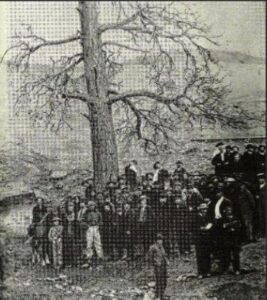 ignoring Slade’s warning to stay out of his territory.
ignoring Slade’s warning to stay out of his territory.
Slade’s temper and the reputation that came with it, combined with a drinking problem, caused his downfall. After he was fired by the Central Overland for drunkenness in November 1862, Slade crossed paths with the Virginia City Vigilance Committee, which was composed of honest, determined citizens, including bankers, storekeepers, miners, stockbrokers, and other citizens of all backgrounds, who had decided to take the law into their own hands and combat lawlessness in Virginia City. Slade found himself in Virginia City, Montana on a drunken spree. After being arrested, he was lynched by local vigilantes on March 10, 1864, for disturbing the peace. Of all the killings he was guilty of, Slade was lynched for disturbing the peace. Unbelievable, but the truth, nevertheless. He was buried in Salt Lake City, Utah, on July 20, 1864.
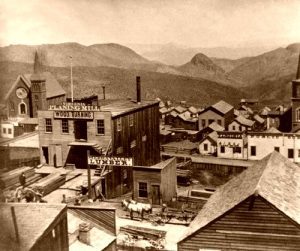 Gold brought miners from the east to multiple areas of the American west…all looking to make their fortune in the gold fields. Unfortunately, it wasn’t just gold and silver miners who flooded Nevada, or any other gold rush area, in the late 1800s in search of their fortunes. The West was indeed wild, and it and the gold also attracted plenty of outlaws and bandits, looking to make their fortune too, but not willing to do the work to mine the gold. Nevada, like other states of the Wild West, attracted its share of outlaws and bandits. One such man, named Andrew Jackson “Jack” Davis, led a gang of thieves involved in robbing stage stops, bullion wagons, and trains in Western Nevada.
Gold brought miners from the east to multiple areas of the American west…all looking to make their fortune in the gold fields. Unfortunately, it wasn’t just gold and silver miners who flooded Nevada, or any other gold rush area, in the late 1800s in search of their fortunes. The West was indeed wild, and it and the gold also attracted plenty of outlaws and bandits, looking to make their fortune too, but not willing to do the work to mine the gold. Nevada, like other states of the Wild West, attracted its share of outlaws and bandits. One such man, named Andrew Jackson “Jack” Davis, led a gang of thieves involved in robbing stage stops, bullion wagons, and trains in Western Nevada.
Davis first arrived in the area in 1859. His plan was to lead two different lives, 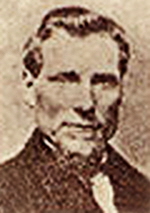 and he carried it out quite well. To the outside world he looked like a legitimate business man when he set up a livery stable in Gold Hill. However, in his “spare” time, Davis and his gang took to the bandit road, taking gold and bullion from any source they could find. Davis built a small bullion mill in Six Mile Canyon east of Virginia City, Nevada. There, he melted down his stolen gold, selling it as legitimate gold bars. He then buried his proceeds so people would not notice or catch on to how wealthy he really was, because after all, how rich could a livery stable owner be.
and he carried it out quite well. To the outside world he looked like a legitimate business man when he set up a livery stable in Gold Hill. However, in his “spare” time, Davis and his gang took to the bandit road, taking gold and bullion from any source they could find. Davis built a small bullion mill in Six Mile Canyon east of Virginia City, Nevada. There, he melted down his stolen gold, selling it as legitimate gold bars. He then buried his proceeds so people would not notice or catch on to how wealthy he really was, because after all, how rich could a livery stable owner be.
On November 4, 1870 the gang robbed the express car of the Central Pacific Railroad near Verdi, Nevada taking some $40,000 in gold coins and bullion. Pursued by lawmen, they were said to have buried the stolen cache along the north bank of the Truckee River, between Reno and Laughton’s Hot Springs west of town, near the site of the long-abandoned River Inn. The entire gang was apprehended and all were sent to the Nevada State Prison, but would not tell where they had hidden their stolen loot. In 1875, Davis was paroled but two 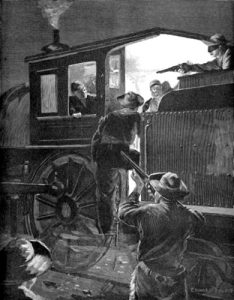 years later, he was shot in the back during a Wells Fargo stagecoach robbery near Warm Springs, Nevada. If Davis ever returned for his cache is unknown, but many believe it is still hidden in Six-Mile Canyon or in the vicinity of the Truckee River. Treasure hunters have long searched these two locations without success. If the money is still there, it may never be found.
years later, he was shot in the back during a Wells Fargo stagecoach robbery near Warm Springs, Nevada. If Davis ever returned for his cache is unknown, but many believe it is still hidden in Six-Mile Canyon or in the vicinity of the Truckee River. Treasure hunters have long searched these two locations without success. If the money is still there, it may never be found.
Another legend abounds that the ghost of Jack Davis protects his treasure in the canyon. Many who have looked for the treasure have been frightened away by the white screaming phantom that is said to sometimes sprout wings and rise into the air. I suppose some would say I shouldn’t be so skeptical, but since I don’t believe in ghosts, my guess is that people just get freaked out, and their imagination runs away with them. Nevertheless, those who think they have seen what they believe to be a ghost, would not be persuaded by my disbelief in same.

